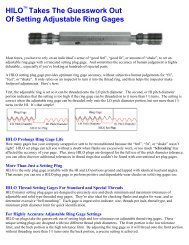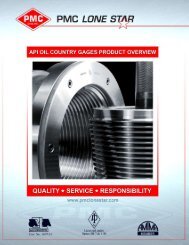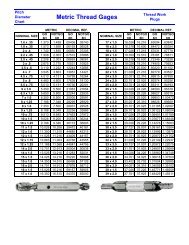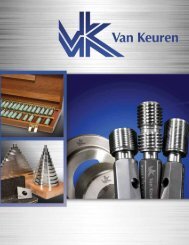A.N.P.T. & N.P.T.F. Pipe Thread Gages
A.N.P.T. & N.P.T.F. Pipe Thread Gages
A.N.P.T. & N.P.T.F. Pipe Thread Gages
Create successful ePaper yourself
Turn your PDF publications into a flip-book with our unique Google optimized e-Paper software.
A.N.P.T. & N.P.T.F. <strong>Pipe</strong> <strong>Thread</strong> <strong>Gages</strong><br />
For Gaging Internal <strong>Thread</strong>s – A.N.P.T. or N.P.T.F.<br />
In gaging internal threads, wither A.N.P.T. or N.P.T.F., there are three aging members involved: (1) L-1 thread plug gage which<br />
checks the thread elements within hand tight engagement; (2) L-3 thread plug which checks the threads that will be engaged<br />
when wrench tight; and (3) 6-Step plain plug which is used to check the minor diameter of the female fitting.<br />
For Gaging External <strong>Thread</strong>s – A.N.P.T. or N.P.T.F.<br />
In gaging external threads, either A.N.P.T. or N.P.T.F., there are three more gages employed: (1) 6-Step plain ring which checks<br />
the major diameter of the male fitting; (2) L-1 (thin) ring which checks the thread elements over the distance of hand tight<br />
engagement; and (3) L-2 (thick) ring which checks the thread elements of those threads engaged when wrench tight.<br />
A.N.P.T. and N.P.T.F. are not meant to be interchangeable
GAGING PRACTICES<br />
TAPER PIPE THREAD GAGES<br />
N.P.T. (National Taper <strong>Pipe</strong>)<br />
To gage Internal N.P.T. taper pipe threads, screw the N.P.T. thread plug firmly into the product – do not force. The<br />
thread is within the permissible tolerance when the gaging notch of the plug is not more than one turn plus or minus from being<br />
flush with the end of the product. N.P.T. plugs are regularly furnished with the basic step only. Minimum and maximum steps can<br />
be added on request. To gage External N.P.T. taper pipe threads, screw the N.P.T. thread ring on to the product as far as it will<br />
go without using force. If the face of the small end of the ring is flush with the face of the product the thread is basic. The<br />
permissible tolerance is one turn plus or minus from basic.<br />
A.N.P.T. (Aeronautical National <strong>Pipe</strong> Taper)<br />
A.N.P.T. internal taper pipe threads are basically the same as the N.P.T. pipe threads except that for Army and Navy<br />
Aeronautical use they must be more carefully controlled for diameter, taper and thread form.<br />
To gage Internal A.N.P.T. taper pipe threads, check first with the A.N.P.T. L-1 thread plug gage. This plug differs in<br />
dimensions from the N.P.T. plug and has minimum and maximum steps in addition to the basic step. If the face of the product is<br />
between the minimum and maximum steps of the plug, the product is in tolerance. The A.N.P.T. L-3 plug gage is used to check<br />
the three threads beyond the L-1 depth. As a check on taper the “reading” on the L-3 thread plug must be within one-half turn of<br />
the “reading” on the L-1 thread plug gage. The truncation is checked with a six-step plain taper plug gage. This plug has<br />
minimum and maximum truncation steps for each of the three pitch diameter conditions – Minimum, Maximum and Basic. If the<br />
L-1 plug shows the product to be basic pitch diameter, the face of the product should lie between the basic minimum and the basic<br />
maximum steps of the truncation plug. If the pitch diameter is minimum, the part should fall between the MN and MNT step. If the<br />
pitch diameters maximum, the part should fall between the MX and MXT steps. No appreciable shake or wobble is permitted.<br />
Shaky fit indicates taper error.<br />
To gage External A.N.P.T. taper pipe threads, first check with the A.N.P.T. L-1 ring. The small end of the ring must be<br />
within one turn plus or minus of being flush with the end of the product thread. Note exactly what this “standoff” is and compare it<br />
with the “standoff” obtained with the A.N.P.T. L-2 thread ring. As a check on taper the total tolerance on standoff variation<br />
between the L-1 and L-2 rings must not exceed one-half turn. The truncation is checked with a six-step plain taper ring gage.<br />
This ring has minimum and maximum truncation steps for each of the three pitch diameter conditions – Minimum, Basic, and<br />
Maximum. If the L-1 ring shows the part to be basic pitch diameter the end of the part should fall between the B and BT steps on<br />
the six-step plain ring. If the pitch diameter is minimum, the part should fall between the MN and MNT step. If the pitch diameter<br />
is maximum, the part should fall between the MX and MXT steps. No appreciable shake or wobble should be permitted. Lead,<br />
angles and root truncation should be checked whenever possible, by projection as a check on tool wear.<br />
See Military Standard MIL-7105 latest edition for complete specifications<br />
N.P.T.F. (National <strong>Pipe</strong> Taper Dryseal Pressure-Tight Joints)<br />
N.P.T.F. Internal taper pipe threads may be gaged in the same manner as the A.N.P.T. threads. <strong>Gages</strong> are<br />
dimensionally different, however, and must not be interchanged. The turns method may be substituted for the “standoff” method<br />
to compensate for gage and product chamfers. With the turns method, the number of turns are counted from hand tight<br />
engagement to complete release, and the gaging steps are completely disregarded. A tolerance of plus or minus one turn is<br />
permitted from the basic number of turns specified. As a check on taper, the difference in turns between the L-1 and L-3 plugs<br />
shall be within one-half turn of the difference between the basic turns engagement of the plug gages. Truncation must be within<br />
the proper limits on a six-step dryseal plain taper plug gage.<br />
N.P.T.F. External taper pipe threads are checked in the same manner as A.N.P.T. threads. <strong>Gages</strong> are dimensionally<br />
different, however, and must not be interchanged. The turns method may be substituted for the “standoff” method to compensate<br />
for gage and product chamfers. A tolerance of plus or minus one turn is permitted from the basic number of turns specified. As a<br />
check on taper, the difference in turns engagement with the L-1 and L-2 dryseal rings shall be within one-half turn of the difference<br />
between the basic turns engagement of the ring gages.







